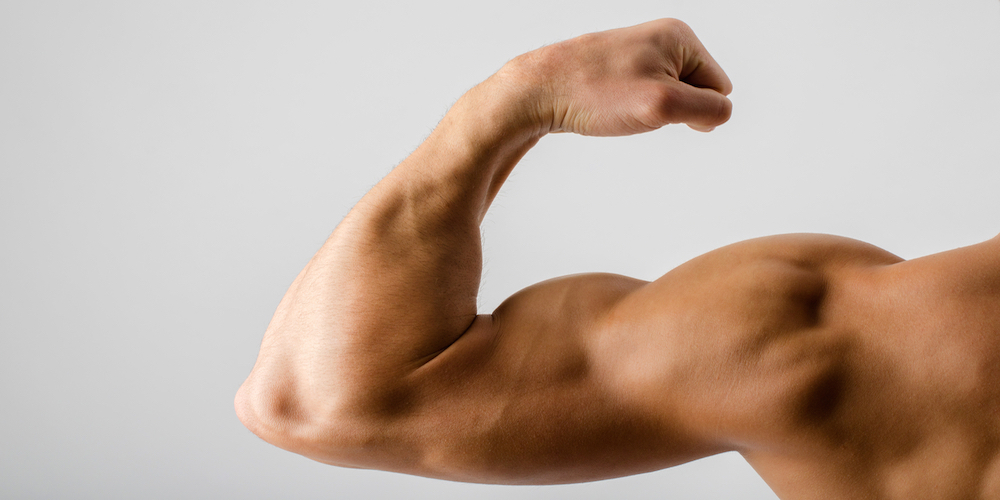While most professional weight lifters bulk up their arms through exercise and diet alone, bodybuilders are among the first people to seek specially designed biceps implants to attain their aesthetic goals.
This practice has attained a certain level of popularity among regular guys as well, as biceps augmentation surgery affords the opportunity to achieve the appearance of larger, more defined muscles in this highly visible and important area of their physiques. It is also performed for reconstructive purposes on patients who suffer from asymmetry and deformities caused by muscle injury.
Surprisingly enough, very little information has been published on biceps implant surgery. Here’s what you need to know before going under the knife.
Who is a good candidate for biceps implants?
Ideal candidates for biceps implants are men (and women) who seek fuller, better defined arm muscles. Candidates should be in good overall health, of sound mind, and possess a clear understanding that the main objective behind biceps implants is aesthetic improvement, and not to expect absolute perfection – even if perfection, arguably a subjective ideal, is often achieved.
To determine if you are a good candidate for biceps implants you will first need to schedule a consultation with a board-certified plastic surgeon. And not just any board or professional guild either, as some organizations hold their members to considerably higher standards and levels of training and experience than others.
If the surgeon you’re considering has been certified by the American Society of Plastic Surgeons (ASPS) or the American Society for Aesthetic Plastic Surgery (ASAPS), you can rest assured that you will be in capable hands. Over the course of your consultation you will be asked about your cosmetic goals and expectations, and provided with detailed information about the procedure itself.
This is the time to present your potential surgeon with any questions or doubts you may have about moving forward with the procedure. There’s no reason to be shy about it. If you don’t feel comfortable asking your doctor certain questions, then he or she probably isn’t the right surgeon for you.
Note that as with most surgeries, certain medicines and the vast majority of herbal supplements must be avoided for a minimum 2 weeks prior to the procedure. The same applies for recreational drugs and alcohol.
And if you’ve been taking anabolic steroids, including testosterone, you need to curb your consumption of these substances for no less than 6 weeks in advance of your biceps implant surgery. This is because many prescription drugs and supplements interfere with your bloods ability to coagulate, which can lead to a host of serious complications.
How is biceps augmentation surgery performed?
Biceps implant surgery typically takes approximately two hours and is performed under either local, regional, or general anaesthesia. All biceps implants on the market today are made of soft, solid silicone.
During surgery, one implant is used for each biceps and placed under the investing fascia of the biceps muscle, or sometimes directly under the muscle itself. According to a recently published study by New York City based plastic surgeon Dr. Douglas M. Senderoff, submuscular biceps implant placement is recommended over subfascial insertion to avoid implant malposition.
In order to place the implant, a 1–2 inch incision is cut into in an inconspicuous crease of the armpit (the axilla crease) and then deepened to extend through the fascia covering the muscle. Once the investing fascia is opened, a pocket large enough to hold the implant is created.
The implants are then inserted and positioned accordingly. Because this area is made up of muscle and fat, scar tissue will form. This is a good thing as it aids with keeping the implants in place. Once this is done, the incisions are closed and a bandage applied to the area in order to reduce swelling and any potential discomfort.
You should be aware that once the anaesthesia wears off the result can be somewhat painful, although the degree of pain people report varies substantially. Regardless, expect to feel some discomfort for the first 48 hours post-surgery. However, this should be considerably mitigated by the prescription pain medication your surgeon provides you.
You will also be prescribed antibiotics to ward off any potential infection resulting from the surgery, and most likely a medication to reduce inflammation as well.

How big can the implants be?
Size is an important consideration when it comes to biceps implants, or for that matter, muscle implants in general. Many guys instinctively ask their surgeons for the largest implants possible, before fully evaluating how their new biceps are going to look in relation to the rest of their body.
“Patient expectations should be considered as there are achievable biceps size limits that may be safely obtained with solid implants,” says Dr. Senderoff.
It’s all too easy to go overboard with the size of your implants and wind up with a result that looks disproportionate, which obviously defeats the purpose of getting biceps implants in the first place. With that being said, any responsible, board-certified plastic surgeon will be conscious of this reality and recommend an implant size that they know will best suit you.
How long does it take to recover from surgery?
Recovery from biceps implant surgery is a significant process that takes approximately one month, and at least six weeks before you will be able to return to all of your usual activities – in particular working out at the gym or engaging in any vigorous exercise.
Immediately after the procedure, you will be instructed to go home and stay in bed for the next 24 hours. With the exception of getting up to eat and visiting the bathroom, you will need to stay off your feet for one week. Over this period you can also expect to have difficulty moving your arms. Plus, compression garments will need to be worn for the first 2-3 weeks post-surgery.
While the exact number of follow-up visits you’ll need tends to vary from doctor to doctor, most patients are usually seen 2 days after their surgery, then weekly for the next 3 weeks, again every 6 weeks after that until they hit the 6-month mark, and finally, once again in another 6 months time. Some physicians further recommend that patients continue their follow-up visits on an annual basis.
What are the potential risks & complications?
While rare, complications from biceps implant surgery, as with any surgery, are always possible. However, so long as patients follow their doctor’s recovery directions to the letter, the chance of experiencing any complications afterward is highly unlikely.
That said, should patients start exercising too soon or otherwise disregard their doctors specific recovery instructions, they create a risk for hematoma, excess swelling, and infections.
Biceps implants don’t tend to shift once they’ve healed in place, but again, if you get impatient and start ignoring your doctor’s orders about limiting strenuous physical activity for the specified amount of time, this can no longer be counted on and you could well find yourself needing to go through the entire process once again, only this time as a corrective surgery.
How much does biceps implant surgery cost?
As with all cosmetic and/or plastic surgery procedures, prices vary from doctor to doctor and region to region. As a general rule, prices tend to be higher in major cities than they are in more rural, less populated areas. That said, in the United States the full cost of biceps implants is typically in the $6,500-$8,000 range.
If those figures are a little higher than your budget allows, remember that many plastic surgeons offer financing and payment plans in the effort to make their services accessible to a greater number of people. Be sure to ask your board-certified plastic surgeon about this at your initial consultation. You might find yourself pleasantly surprised by what they tell you.









